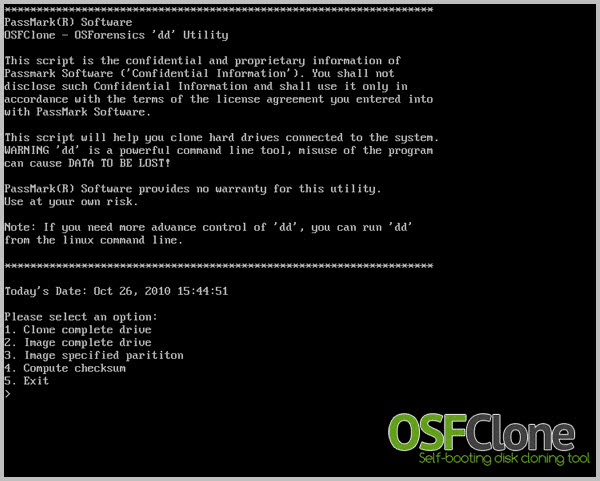OSFClone, Self-Booting Tool To Create Hard Drive Copies

Disk cloning or copying serves several purposes: it can be helpful for users who want to migrate to a larger hard drive for instance, or used for forensic or file recovery purposes as it is usually advised not to work with the original source. You find plenty of disk imaging tools on the Internet, some free, and many commercial.
OSFClone is a free solution that was released in 2011 initially but updated regularly with new functionality.
The program is offered as an ISO image that can be burned to CD or DVD, and as a version for removable storage devices like Flash storage.
The software is self-booting which means that it is independent of operating systems installed on the system. It is based on Tiny Core Linux and boots into a command line interface and not a graphical user interface.
Your first task is to burn the ISO image to DVD, or to copy the contents of the zip file to an USB drive.
The USB installation requires additional steps, like launching ImageUSB.exe once you have copied the files to the drive. The steps are explained in detail on the developer homepage.
You end up with a self-booting image that you can boot from independently of the installed operating system; useful if the installed operating system does not start anymore as well even though it is not a recovery toolkit.
The program loads its basic interface and displays the available options in a text menu. You can use the keyboard to select an entry from the available options:
- Clone complete drive
- Image complete drive
- Image specified partition
- Compute checksum
OFSClone can create raw images of a selected drive or partition, or disk images in the Advance Forensics Format. You need to have enough free space available to create the disk image.
Just type the number of the option to start the linked process. The core difference between creating a clone and an image is the following:
- A clone is a raw copy of the entire drive including all used and unused disk space, file fragmentation and more.
- An image in the dc3dd format which supports extra options such as the creation of file hashes and advanced reporting options.
Another interesting option is the ability to verify that the cloned drive is identical to the drive source, which is done by comparing hashes between the clone and source drive after the creation of the copy.
You can then mount the created image on the same or another computer to analyze, access or recover its contents using the company's OSFMount program for Windows that is also free.
Closing Words
OSFClone is easy to use; that, and the fact that it is OS independent make it an interesting tool for users who want to copy or clone a hard disk on a computer system. The program is free and useful when it comes to analyzing content on a drive or recovering data from it.




























This is all good and fine up until, they start selling the software. I pisses me off very much that the big companies and so called “new one click tool developers” take the best of free/open source tools, wrap it up in a pretty GUI and start selling it under new name. dd has been on the scene for god knows how many years. Clonezilla is one LiveCD that I use on a regular basis and have not experienced any issues with it. The reason as to why I am mentioning CloneZilla is because the cloning/imaging is based on dd, parted image and various other command line tools. In my book, it is OK to revamp something old.stable.useful and put a nice GUi, but making money from it is a different ball game. Hope that this tool stays free.
Regards,
Ivan K.
Hi Martin, this software sounds interesting. But it looks like it’s more for clandestine operations: to copy and view an entire disk (deleted files included). It doesn’t look like its for making a clone drive that you can boot should your original drive die. Or am I missing something?
Dante you are right. The software is only for analysis and file recovery, not for backup or restoration.